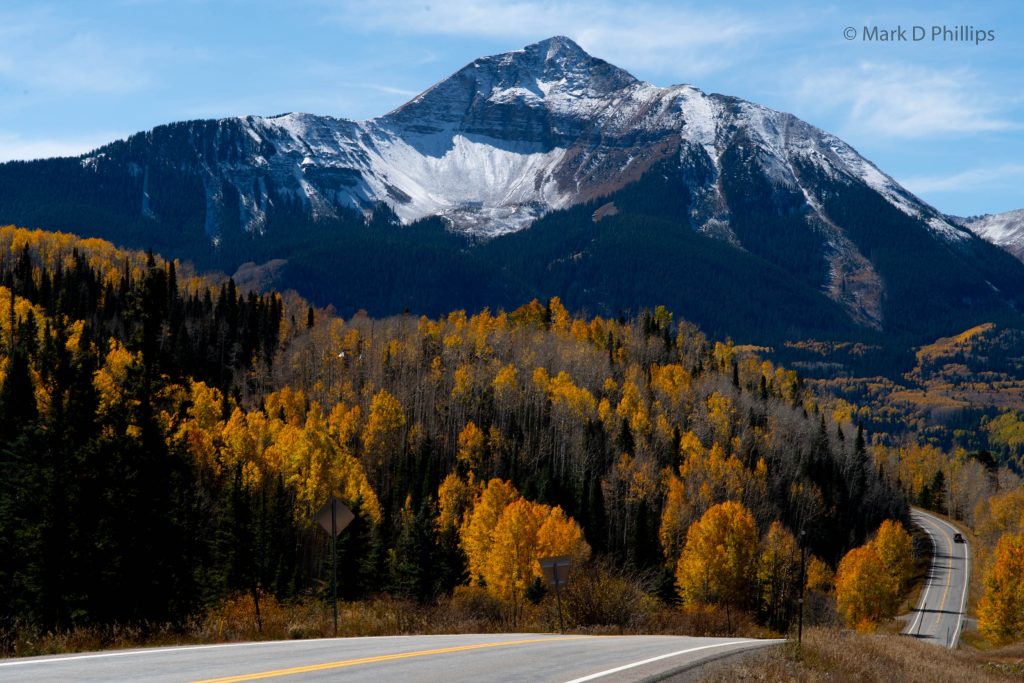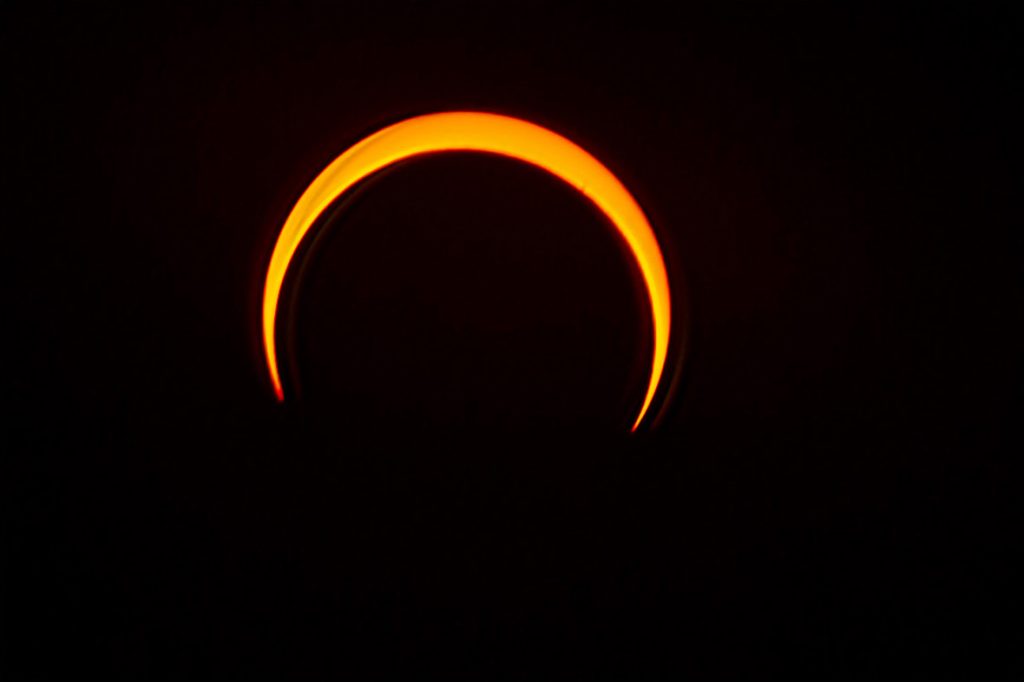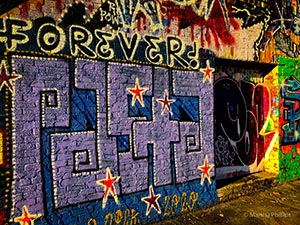
Two photojournalists decide to drive 500 miles across Colorado to Natural Bridges National Monument. Aspen, cottonwoods and the scenery beckon with an annular eclipse as the gold at the end of the rainbow.
What could possibly go wrong?
Chuck Bigger and I were crossing the Rockies, the golden bursts from late autumn led us higher into the sky. When a rockslide closed the main road we were going to take, we pulled out the road atlas to map a new route. This was like Journalism 101 when we were young photographers out to do a job… and our job is going across Colorado taking pictures of the aspens and cottonwoods and ending up at the annular solar eclipse on October 14 in Utah.
Backtracking to Cottonwood Pass, we climb past 9000 feet heading towards the summit and it started to snow. Before long we were in a full-scale blizzard with almost 9 inches of heavy, icy muck on the road. A Tesla in a snowbank had the funny effect of bringing on a conversation wondering if we were in wagons, would we end up being the Dahmer party? It was October 12th for God’s sake… Snow? October? It wasn’t rational. I’m from the East coast. I’m just glad Chuck was driving.
We puttered along in four wheel drive at 10 miles an hour for nearly an hour and a half topping out at 12,126 feet, then dropping back down to the land of yellow trees. Crossing arctic tundra into semi-arid landscape with the looming mountains and the snow storms pummeling their summits, we saw views we’ve never seen anywhere in America.
Discovering the Americana of the Burger Boy in Cortez, CO, was icing on the cake. Real carhops, real chocolate shakes, real hand made burgers… it was one of those meals that will stand out forever. The Gonzales family has created a work of art disguising itself as a drive-in.
We arrived in Monticello, Utah, in the dark, and we left it in the dark, driving to Natural Bridges National Monument with no idea what the landscape looked like. Driving through absolute darkness in Utah, nothing existed outside of our headlight beams except Jupiter and the stars.
We pulled into the visitor center in the park right at Civil sunrise. Rangers told us people had been arriving since 4 AM so we madly dashed back to our cars because they told us once all the car parking places were taken, they would close the gates and no more cars would be allowed in.
Driving the park loop, we got our first views of a scene right out of a classic western movie. White Canyon contains three magnificent natural bridges sculpted by water in a landscape that reminds us of the power of nature. President Theodore Roosevelt declared it Utah’s first National Park Service Area in 1908, four years after National Geographic publicized the bridges.

We passed the parking areas for the first two trailheads, which had nearly every parking space taken. These longer trails stretched nearly eight miles, taking visitors to Kachina Bridge, named for rock art on the bridge that resembles symbols commonly used on kachina dolls, and Sipapu Bridge, meaning “the place of emergence,” an entryway by which the Hopi believe their ancestors came into this world.
We had decided on Owachomo Bridge, the “rock mound,” a feature atop the bridge’s east abutment, and the furthest from the visitor center but the shortest hike from a parking area. We utilized multiple online programs to pick the location for our shoot. And just so everyone knows, these were not historical names. They were Hopi names assigned to the bridges by the General Land Office to offset the names “President,” “Senator” and “Congressman” penned by Cass Hite, a gold prospector who is credited as the first non-native to discover the bridges. In actuality, the canyon contains relics from 7000 BCE and cave dwellings related to Mesa Verda from A.D. 1270.
As the sun came up and people began moving from their cars, we met the team of cinematographers from Chicago who drove down for a specific shoot of the arch. I talked with different eclipse chasers like me. The couple with their teenage son who decided after 2017 they had to see more eclipses.
Over Facebook, I met Photographer Hayne Palmer IV, who decided late in the game to go to Natural Bridges from San Diego.
Arriving the day before, “a group of other photogs made clear that they viewed every single spot as first come, first serve, on the morning of.”
So Hayne spent the night with two others under Sipapu.
“I actually wanted to thank those photogs because that was an amazing night. Cold, but an awesome experience I’ll never forget,” he told me on FB Messenger. “As stressful as it was, such as getting a campsite, picking and holding a tripod position, making 37 exposures over several hours while praying no one bumps my tripod, I really had a great experience. Mainly because I met so many cool people. And those stars at night! Best I’ve ever seen. Did my mind good.”
His photos are some of the best: https://www.haynepalmour.com
With first contact of the moon to the sun, I knew I was totally unprepared for photographing the action. For every other eclipse, I had meticulously planned out the short time available for photographs. I decided to enjoy the event and not stress whether I got images throughout. I watched through my glasses as the moon began to eat the sun, attacking from the top and not from the side as I was used to. It was incredible just watching and feeling the enormity of where I was for this celestial event with a group of people as excited as I was.
First contact was 9:10:20 am in Utah. As totality approached, nothing really changed. At 10:29:08 with totality, the sun had no difference in brilliance. Shooting at maximum aperture on my two lenses at 1/8000 of a second, the body of the moon becomes visible in the blazing fury of Sol. You learn how many imperfections are in the glass of your lens, giving shapes that were not there. But maybe they were? I couldn’t look directly at the eclipse.
Through the glasses provided by the ranger at Natural Bridges, it was phenomenal. It was a ring of fire in the sky, just not visible with the naked eye. Am I glad I saw it? Definitely.
Was it comparable to a Total Solar Eclipse? Not for me. Where will I go in April 2024? I’m not going to worry about the photographs once more. During the Annular Solar Eclipse, I could not tell any difference during totality.
Now, I will not take the time for granted. With 3:34 seconds of totality in April, that connection to the universe is something I will cherish. When the light fades, the crickets chirp, and the stars appear in the day, how can you not look up into the face of God?

Story and photos by Mark D Phillips, www.markdphillips.com; Photojournalist and traveler…….
Photos by Chuck Bigger; www.chuckbigger.com

